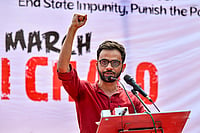I was in Washington at the time, reporting for The Telegraph and few Americans made an attempt to see India's point of view, leave alone try to understand it. A celebrated US academic even compared India to a "rogue state". It wasn't always clear if the Clinton administration was offended more at the defiance, or the act itself. Rubin's arrogance—he was the public face for the under-privileged Indian journalists—was difficult to take and I remember going up to Rick Inderfurth, the then assistant secretary for South Asia, after a press briefing to say the daily scolding was poisoning the friendship between the two people. The quarrel was of governments but the American overreaction was hurting the overall relationship. Inderfurth listened and nodded.
Talbott's book is the story of what happened after the maelstrom of May 1998 and how India and the US began the difficult phase of re-engagement and rapprochement. As deputy secretary of state and the No. 2 man in America's diplomatic pantheon, he conducted a dialogue of 'equals' with Jaswant Singh. Detailed and revealing, it is an honest behind-the-scenes look at how countries make and defend policies. The dialogue led to Bill Clinton's evocative five-day visit to India in 2000, the first by a US president in more than two decades. The book is surprisingly objective and determinedly without rancour. It is a must-read for any student of diplomacy, specially those who can't see the forest for the trees. If diplomacy is the art of the possible, then Talbott and Jaswant surely perfected it in their intense interaction. They showed how two intelligent men can learn to deal with each other.
Talbott's reporting skills as a former Time magazine journalist are magnificently at play in the book. He even quotes Jaswant's mind-bending sentences verbatim. His account spills with interesting details, making a subject which in other hands could have been eye-crossingly dull seem comprehensible. Not too many can turn a "strategic restraint regime", "minimum nuclear deterrent" and the Comprehensive Test Ban Treaty into scintillating topics. He dwells on them but just enough, letting the journalist dominate the diplomat. Built around the technical issues is a very human story of two men who worked hard to bridge the gap between their countries. It was the first time a senior and serious US official had sat down with an Indian leader to talk about the Grand Canyon of differences and reached an understanding on which the Bush administration has built in recent years.
The book is a racy read, a James Hadley Chase of diplomacy, from the time Talbott turned onCNN to find out about the tests and alerted the CIA to airport cafes and restaurants in Rome where he met Jaswant to persuade him to establish restraints on India's nuclear weaponsprogramme. It moves so fast, one can barely digest the wide implications of Talbott's prescriptions and Jaswant's resistance. Yet their teams achieved enough understanding that today there is talk of space and nuclearcooperation. The parallel dialogue with Pakistan was frustrating and largely fruitless for Talbott. Nawaz Sharif struck him as a feckless, almost pathetic figure, while his diplomats were "querulous, surly and sometimes abusive". Once a Pakistani diplomat even lunged at Talbott during talks trying to grab his neck when the US side asked why Pakistan always responded to Indian action in a "knee-jerk" fashion. Inderfurth called it "Jaswant envy".
By contrast, Talbott's treatment of the Indian arguments, demands, concerns and above all Jaswant Singh is sympathetic and even admiring. There is none of the usual American "know-it-all" tone which creeps into writings about security issues—we know what's best for you. He seems impressed by the Indian team's professional and masterly grasp of the nuclear arcana. Alok Prasad, currently ambassador to Singapore, and Rakesh Sood, now deputy chief of mission in Washington, earn special praise for being persistent. But Jaswant dominates the book. Talbott tries hard not to criticise him even when faced with the kinder, gentler Hindutva of the minister.
And to think that the Talbott-Jaswant dialogue almost didn't happen. After the blasts, Clinton saw red and got a brainwave to bear down on India with Boris Yeltsin and Jiang Zemin. The "troika" idea sent both him and Yeltsin into raptures but thankfully Talbott and his Russian counterpart saw it for what it was—a recipe for disaster. Talbott gently told the "chief", and Clinton sheepishly admitted later it wasn't the best idea. Then Jimmy Carter tried to insert himself as the mediator at Nawaz Sharif's desperate prodding but Talbott killed the idea with bureaucratic foresight.
Incidentally, Atal Behari Vajpayee, for all his famed oratory, was barely audible to the Americans either in person or over the phone, often making Clinton puzzle over his cryptic responses. But Clinton, who came into office wanting to engage India, kept the political goals in mind, making compromises to move relations along. Talbott's recounting of the Clinton-Sharif meeting during the Kargil crisis is an example of the positive influence the Americans can exercise in a crisis. Clinton berated Sharif when the Pakistani leader desperately sought to link the Kashmir issue to withdrawal of his troops. If Clinton's account of this seminal turn in US-Indian relations in My Life was lacklustre, Talbott's is alive like a movie.
In the end, Talbott didn't get from Jaswant what he wanted—India's signature on theCTBT—while Jaswant did succeed to an extent in making the Americans take India's security concerns seriously. But Talbott doesn't seem to hold it against India.


























